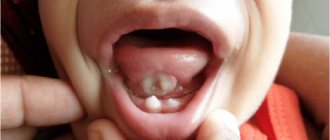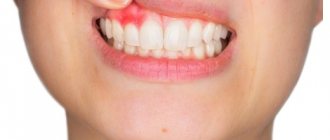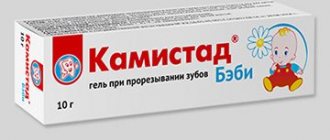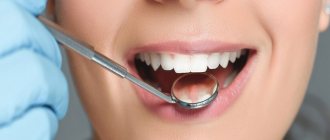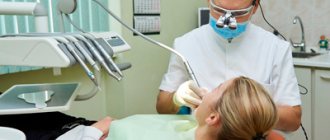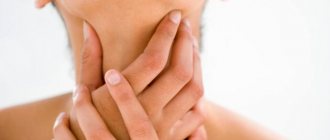From this article you will learn why pimples appear on the roof of your mouth and how to treat them.
Various swellings and bumps in the mouth can appear in any place - on the cheeks, gums, under the tongue. Depending on the cause, symptoms may vary. In most cases, the tumors are not harmful and do not require special treatment.
Pimples can vary in size - be small or large, hurt a little or not show up at all. They also differ in color. Let's find out what is the reason for the appearance of these tumors, as well as how you can get rid of them.
Bumps in the mouth: what they are, their causes and treatment
Any neoplasms in the oral cavity require careful study of the clinical picture. This can be either a harmless growth or an alarming signal from the body. Thus, a lump on the roof of the mouth often occurs as a result of a cold or infection. This formation does not cause discomfort and resolves on its own after strengthening the immune system. If the growth is accompanied by pain and other unpleasant symptoms, this may indicate a serious pathology. Only a doctor can determine the cause of the lump and tell you what to do.
Rash in the mouth in children
Unlike adults, children's bodies are much more often and more severely exposed to various bacterial, viral and infectious lesions. Most often, the penetration of pathogenic microorganisms occurs through the oral cavity, if only because children are constantly trying to taste everything, and because their habitat is closer to the floor.
Below we consider the most common pathologies that may be associated with the development of a rash in the mouth:
- Viral pemphigus. Along with the appearance of small blisters in the mouth, they may appear on the child’s hands and buttocks. The pathology is transmitted by airborne droplets, most often this happens in kindergartens, in stores where there are large crowds of people. On average, therapy lasts 7-10 days, if you contact your pediatrician in a timely manner.
- Stomatitis. Since the child regularly comes into contact with various contaminated objects (toys, unwashed vegetables, fruits, things from the floor and much more), bacteria constantly enter his mouth. Most often, stomatitis occurs in children who go to kindergarten. The pathology may not have pronounced symptoms, but can cause serious discomfort, increased body temperature and soreness, to the point that the child categorically refuses to eat. With the help of special topical medications, the intensity of symptoms can be reduced.
Stomatitis in children is also called thrush and candidiasis.
In adults, this pathology may not cause discomfort, but children often react very sharply to this disease. If thrush has not been completely cured, a rash may reappear in the mouth. The most harmless and quite effective thing that parents can do in this case, even before contacting a doctor, is to treat the oral mucosa with a soda solution and gauze soaked in it.
Most often, in children, the rash goes away quite quickly, without any complications, since their immune system works in this regard much more efficiently than in adults.
Still, it is better to take care in advance and prevent such excesses, so it is regularly necessary to monitor the hygiene of the child’s oral cavity, as well as the hygiene in the house where the child is most often located.
Why do bumps appear in the sky?
A growth in the mouth appears as a result of blockage of blood vessels and stagnation of organic fluids, which causes inflammation in the mucosal tissues. Among the most common causes of pathology are the following:
- bad habits – alcohol abuse and smoking;
- chronic diseases – sore throat, sinusitis;
- constant exposure to traumatic factors - incorrectly fitted crowns that become infected, eating too hot food, sucking on lollipops, etc.;
- insufficient oral hygiene - food remains behind the teeth become a favorable environment for the development of pathogenic microflora;
- inflammation of the salivary glands;
- colds and infectious diseases;
- Doctor’s mistakes – incorrect filling or tooth extraction.
A child can also develop a lump in the mouth. In most cases, the pathology occurs due to bruises, which are quite common in childhood.
Bumps also form in the mouth due to cancer (leukoplakia and papillomatosis), which pose a great danger to human health and life.
Causes of acne in the mouth
Pimples on the roof of the mouth can develop for all sorts of reasons, ranging from harmless to quite dangerous pathologies. Therefore, it is very important to promptly determine the etiology of such a rash.
Dental pathologies
Dental disease is the main root cause of the development of inflammatory rashes in the mouth. Improper oral hygiene, injuries, mechanical damage, improper installation of dentures, braces, and so on - all this can cause uncomfortable plaques and pimples in the mouth.
So, if inflammation of the tooth root occurs, small pimples often develop in the mouth, which can be yellowish or white. However, 80% out of 100, acne on the roof of the mouth is stomatitis or an inflammatory process on the mucous membrane.
Infections
Infectious diseases also often become the root cause of rashes, which is less often observed in adults, and more often in children. Inflammatory process in the throat, cough, viral infections are the primary sources of small rashes in the mouth.
This kind of disease can be accompanied by malaise, hyperemia, and a white coating may appear on the mucous membrane of the throat, which is also a fairly serious reason to visit a doctor.
In children
In most cases, a rash in the mouth in children is an infection that has entered the child’s mucous membranes, but there are other factors at play.
Among them:
- Measles. With measles, the rash looks like green-white papules that go away on their own after a few days. And if the rash goes away without treatment, then the pathology itself must be treated, as it has a number of serious complications and consequences.
- Chickenpox. The pathology provokes damage to the mucous membranes and skin, but rashes do not always occur and some children suffer from this disease without a rash at all. If left untreated, there may be risks of complications and severe disease.
- Thrush. With thrush, also known as candidiasis, a white pimple or plaque appears, and sometimes the pimple can bleed. It can cause severe pain, and sometimes children refuse to eat.
- Dysbacteriosis. A common disease in young children that causes a bloody rash. This is a sign of disturbed intestinal microflora.
If a child, along with a rash in the mouth, experiences moodiness, weakness, fever, or refusal to eat, you should consult a pediatrician for a correct diagnosis and treatment.
In adults
In adults, other pathologies can provoke rashes in the oral cavity:
- Herpes infection. Transparent pimples, inside of which you can see clear liquid. An exacerbation of the pathology is observed as a result of the weakened functioning of the human immune system.
- Glossitis. With this pathology, pimples are red, bloody, and can appear with excessive alcohol consumption, allergic reactions, or poor diet. Acne is painful. Without proper treatment, a crust may appear on top of the pimple.
- Syphilis. White pimples on the roof of the mouth can be painful and occur when infected with a serious disease such as syphilis. The rash can be very diverse; completely different parts of the oral cavity can be affected.
- Inflammation of the roots of the teeth. White and yellow pimples, which appear when the roots of the teeth become inflamed, are accompanied by tooth pain.
In pregnant women
Most often, a rash in the mouth during pregnancy occurs due to a pathology such as stomatitis. As a result of disrupted hormonal levels and weakened immune defenses of women, the mucous membranes are affected.
Self-use of various medications can harm both the woman and the child. Therefore, it is better to consult a doctor to select suitable medications.
General symptoms
A tumor formed in the oral cavity can be of different colors: white, dark red, blue, transparent yellow. Sometimes it is soft, in other cases it is dense. A lump that appears against the background of one pathology may differ depending on the individual characteristics of the patient’s body: age, general condition of his body, bad habits, etc.
The lump appears in the form of a bubble, growth, ball, compaction, tumor with faint edges. Spots (change in color of the mucous membrane) may also form in the affected area. In some cases, numbness is felt in a certain part of the oral cavity, difficulties appear when swallowing, and the voice changes. In advanced forms of the disease, the cones may be damaged, which provokes bleeding with an unpleasant taste and odor.
Painful lumps indicate inflammation and suppuration. General health worsens, body temperature may rise. Purulent intoxication of the body occurs. In this case, the lump grows, it becomes hard and hot, and the regional lymph nodes enlarge.
Treatment of acne on the roof of the mouth
To eliminate rashes in the oral cavity, it is necessary to find out the cause of their occurrence in order to choose the right medications or traditional medicine to eliminate the disease.
Medicines
Depending on the factor that provoked the rash, the drug is selected. Usually these are agents with a local antibacterial effect that reduce the inflammatory process. If there is pain, it is also possible to use local analgesics.
If the cause of the rash turns out to be fungal stomatitis, then it is necessary to use special preparations with an antifungal effect, for example, antifungal gels and rinsing solutions.
Gargling with antiseptic solutions will help reduce the number of pimples in your mouth. If the cause of the rash is an allergic reaction, it is necessary to eliminate contact with the allergen and also take an antihistamine.
Also, in some cases, medications may be prescribed to strengthen the immune system so that the body can cope with the pathology as quickly as possible.
Folk remedies
Most often, alternative medicine methods are used not independently, but in combination with medications. In addition, in most cases, folk recipes simply will not help in any way to cope with the existing problem.
The safest and most effective remedy that reduces inflammation in the mouth, reduces discomfort and itching is a soda solution for rinsing. To prepare it, pour a teaspoon of soda into a glass of warm boiled water, mix and use for rinsing.
Other recipes to reduce oral rashes:
- Oak bark solution. To do this, take a tablespoon of oak bark per glass of boiling water, cool the broth, and then strain. Rinse your mouth at least 4-5 times a day.
- Add a tablespoon of calendula, yarrow, chamomile to a glass of boiling water, let it brew for at least 20 minutes. Strain and rinse your mouth 3-5 times a day.
To prevent the development and proliferation of pathogenic bacteria in the mouth, it is necessary to regularly monitor oral hygiene, eat right, avoid bad habits, and pay special attention to sleep and rest.
Do not forget that any pathology is a reason to see a doctor, and self-treatment and the use of medications can provoke a worsening of the situation and an increase in symptoms, which will lead to serious consequences in the future.
Diagnosis of diseases accompanied by the formation of lumps in the mouth
Tumors have appeared in the mouth, and the question is, which doctor should I contact? This symptom is a prerequisite for visiting the dentist. To diagnose the disease, the doctor will first conduct a visual examination and palpation, and collect an anamnesis. A puncture is taken from the resulting lump and a bacteriological examination is carried out, which makes it possible to determine the cause of its occurrence.
Based on the results obtained, the doctor determines the need to use other diagnostic methods:
- general tests;
- X-ray;
- Ultrasound;
- biopsy.
If the cause of the formation of a lump on the upper palate is beyond the scope of the dentist’s competence, the patient is prescribed consultations with other specialists (pediatrician, therapist, gastroenterologist, endocrinologist, hepatologist). Only after making a diagnosis will the doctor determine how to treat the disease.
Preventing acne in the mouth
The key to a healthy oral mucosa is careful and regular hygiene. It is necessary to spend time daily brushing your teeth at least twice a day, if possible after each meal, using dental floss and mouthwash. Avoid all kinds of mechanical damage to your mouth - scratches, bites, and so on.
Visit your dentist regularly, at least every six months. Treat caries and other dental pathologies in a timely manner.
Don’t forget that if you eat improperly, you can also often encounter various inflammations in the mouth or on the skin. Therefore, give preference to proper nutrition, exclude heavy and unhealthy foods, and if necessary, consult a nutritionist to determine your diet and eliminate food allergies.
If you have pathologies of the digestive system, it is necessary to reduce or completely eliminate the consumption of foods and dishes that provoke the inflammatory process. When the condition of the gastrointestinal tract organs stabilizes, there will be much less inflammation in the oral cavity.
In any case, various microbes from the outside world constantly enter the human body, so do not forget to take care of your immune defense. To do this, exercise regularly or at least spend time actively (walking in the fresh air), devote enough time to sleep and rest, and eliminate bad habits.
A rash in the mouth is the result of a pathological effect. Depending on the type, color, structure and nature of these neoplasms, it is possible to determine the disease that caused acne in the mouth.
Which doctors should you contact if you have a rash in your mouth? Most often, it is necessary to visit several specialists at once - a dentist, a therapist, a dermatologist and an otolaryngologist.
Dental diseases
At an advanced stage of periodontitis, a fistula forms near the tooth involved in the painful process. If periostitis (inflammation of the periosteum) develops, flux may appear. At first the lump is hard, but over time it becomes softer and filled with pus.
In case of periodontitis, the tooth is unfilled and the root canals are cleaned. After removing the exudate, oral baths are prescribed using special solutions. In case of periostitis, the dentist opens the tooth, places medications in the cavity, and closes it with a temporary filling. If this treatment does not help, the tooth is removed.
How to treat acne on the roof of the mouth in children and adults?
Treating acne in the mouth is much more difficult and dangerous than treating acne present on the face and body.
Since these outbreaks are in the mouth, you cannot use regular acne medicine such as blemish and pimple cream or toning lotion as these medications cannot be taken orally. If you are tempted to pop a pimple, it is highly recommended not to do so.
Nails can damage the skin and cause bacteria to form in pimples. Since the oral cavity is a source of bacteria, you can make things worse. Avoid constantly touching pimples, as the process of formation of inflammation will quickly worsen.
You can ease the discomfort and get rid of acne on the roof of your mouth faster by using a few simple home remedies:
Using salt water or baking soda
Use baking soda or salt water to get rid of pimples on the roof of your mouth.
How to use?
- Add a few teaspoons of salt to a glass of warm water. After rinsing your mouth, spit out the solution, repeat the procedure two or three times a day.
- An alternative to this is to make a baking soda solution. Mix one tablespoon of baking soda with a medium cup of warm water. Rinse your mouth with it and then spit it out.
Hydrogen peroxide solution
How to use?
Prepare a 3% hydrogen peroxide solution to clear away pimples on the roof of your mouth.
- Pour a small amount of hydrogen peroxide into a plastic cap and mix with an equal amount of water.
- Dip a cotton swab into the peroxide solution and apply it only to the inflamed pimple.
- Twist the cotton swab and repeat the procedure.
Be careful not to swallow any of the hydrogen peroxide drops if possible.
Hydrogen peroxide is an antibacterial agent that reduces the number of bacteria present in the mouth and helps treat acne. The ulcer should go away in about three to four days if you do it twice a day.
Essential oils as a remedy for acne on the roof of the mouth
Home spray recipe:
Eucalyptus and peppermint essential oils have anti-inflammatory properties and also act as antimicrobial astringents to help tighten the tissue around the pimple, relieving further discomfort caused by tenderness or potential bacterial buildup. The soothing properties of both of these oils can also soothe an irritated and inflamed oral area .
What you need?
To make a spray with these two oils, you will need:
- Two tablespoons olive or grape seed oil
- Peppermint essential oil: ten drops
- Eucalyptus essential oil: eight drops
- Glass bottle
What do you need to do?
Pour olive or grape seed oil into a bottle and stir in essential oils. Close the bottle, shake it well and apply with a cotton swab directly to the pimple sore if needed for relief. Shake before use each time.
Mouth rinse for acne on the palate
You have two options for mouth rinse:
- Dexamethasone, which is a steroid mouth rinse that reduces pain and inflammation Dexamethasone reduces the number of relapses, but this treatment option is usually reserved for more severe cases.
- Tetracycline is an antibiotic used for more extreme cases. Your pimples will heal quickly, but your mouth will be vulnerable to a fungal infection called thrush Thrush is a fungal infection caused by yeast in the lining of the roof of your mouth.
An effective natural remedy for Peppermint that quickly kills any acne!
Surgical treatments for acne on the roof of the mouth for cancer may include
- Removing a tumor surgically Your doctor may cut away the tumor and clear away the area of healthy tissue that surrounds it Tumor removal can be done with minor surgery Larger tumors may require more extensive surgical procedures For example, to remove a large tumor, the surgeon may also remove part of the jawbone or even part of your tongue.
- Surgery to remove cancer that has spread to the neck If cancer cells have spread to the lymph nodes in your neck, your oncologist may recommend a procedure to remove the affected lymph nodes and surrounding tissue in the neck (neck dissection).
- Surgery to Rebuild Your Mouth After surgically removing a tumor, your surgeon may recommend reconstructive surgery to restore the appearance of your face or to help you regain your ability to speak and eat. Your doctor will transplant skin, muscle tissue, or bone grafts from other parts of your body to restore your face. Dental Implants are used to replace natural teeth.
- Surgery carries high risks of infection and bleeding. Surgery for oral cancer often affects the patient's ability to eat, speak, and swallow.
Radiation therapy
Radiation therapy involves the use of high-energy beams such as X-rays to kill cancer cells. Radiation therapy can be administered from a machine outside the patient's body (external beam radiation) or from radioactive seeds and wires placed near the affected area (brachytherapy).
Treating oral cancer with radiation therapy may be the only course of treatment recommended if your tumor is found at a very early stage. Radiation therapy can also be used after surgery. In some cases, it is combined with chemotherapy. This combination increases the effectiveness of radiation therapy, but also increases the risk of adverse effects. that you may have For patients with advanced oral cancer, radiation therapy may help treat symptoms caused by the cancer.
Unpleasant side effects of radiation therapy on your mouth may include tooth decay, dry mouth, mouth ulcers, bleeding and stiff jaws, fatigue and redness.
Precautions when treating acne on the palate in adults and children
- Brush your teeth as gently as possible Maintain oral hygiene daily, also use dental floss and rinses.
- Avoid Stress and Relaxation Acne flare-ups are widely associated with stress during times of intense emotional depression. Acne on the roof of the mouth can be aggravated by stressors.
- Pay attention to your diet and avoid fatty, oily foods.
- Avoid spicy or hot foods, which can further irritate acne Peppers and carbonated drinks should be avoided Fruits and vegetables such as oranges, pineapples, lemons, apples, tomatoes and strawberries can also cause acne.
- Increase your intake of vitamin B12, zinc, iron and folic acid If you need to take vitamin supplements, you should first consult your doctor or nutritionist.
- Try not to irritate the inside of your mouth. Avoid smoking and using tobacco.
Angioma
It is a benign formation, which in most cases is a congenital pathology in children. It consists of blood vessels and is dark red in color. Sometimes it looks like a small ball on a leg. Lymphangioma, formed from lymphatic vessels, most often appears on the soft palate. It looks like a small bump with a bubbly surface. First, the tumor grows inside, then a swelling appears that hurts.
The choice of treatment method depends on the type of vessels. The angioma is removed or reduced by sclerotherapy, alcohol injection, or radiation therapy. If there is a risk of severe swelling, the formation is excised with a scalpel. The ball-shaped angioma is removed using a galvanoacoustic loop.
White pimples on baby's palate: reasons
There are quite a few reasons why pimples appear on the roof of the mouth in babies. Let's look at each of them in more detail.
- Tongue injuries
All babies, when they turn three months old, begin to actively explore the world. They try to taste everything. But not every object that ends up in the mouth is sterile.
Older children develop the habit of chewing on everything, and some objects may well scratch or injure their tongue.
So, even with a small scratch, the mucous membranes can become inflamed and pimples appear on the palate. Most often they appear on the tip of the tongue.
- Candidiasis and thrush
Thrush
In babies under one year of age, the immune system is still developing, and therefore it does not have the ability to resist most bacteria. So, any disease inevitably reduces immunity, which is already weak.
This can cause thrush. The reason is that the Candida fungus begins to actively multiply. It can also occur after taking antibiotics.
By the way, thrush, along with pimples, also causes plaque in the mouth. It is dense and white. It spreads throughout the mouth. If you remove the plaque, the skin underneath will be red and ulcers may even appear. The latter, as a rule, appear when the disease is already quite advanced.
- Stomatitis
With this disease, many pimples appear in the throat area. They cause pain and also interfere with normal eating and swallowing. They often burst because food irritates them. With a complex form, the child may have a fever and feel weak.
- Allergy
Children under two years of age are most often susceptible to allergies. One of its symptoms is small pimples on the palate. These rashes are mainly cause for concern because they are itchy and painful when swallowing and eating. The body temperature does not increase.
- Angina
We all know that this disease is infectious. It affects the tonsils. They become inflamed and painful. In addition, the infection can spread to the palate, manifesting itself as pimples. They are white and can hurt, and a white coating appears on the tongue.
If the pus is removed, redness immediately becomes visible, and the mucous membrane swells. The formations hurt a little, interfere with swallowing normally and greatly affect the child’s well-being. He becomes capricious, loses his appetite, and has a high fever.
- Herpetic infection
Herpes infection
When infected with the herpes virus, exacerbations periodically occur. They manifest themselves as the appearance of various pimples on the tongue and palate. They can even appear on teeth. When they open, an ulcer appears. It causes discomfort, but with proper treatment it goes away quickly.
- Dysbacteriosis and unbalanced nutrition
When a child does not eat properly, it sooner or later spoils the microflora of his intestines. As a result, glossitis often develops. The mucous membrane of the tongue becomes inflamed. The papillae of the tongue are divided and resemble white pimples in appearance. The disease can also affect the mucous membrane of the palate. They generally do not bother the baby, although they may be sensitive to hot or cold foods.
Preventive measures
To reduce the risk of developing pathologies in the oral cavity, you should follow a number of recommendations:
- quit smoking and alcohol;
- normalize nutrition - do not eat hot, salty and spicy foods, introduce fermented milk and plant products into the diet;
- carefully and regularly observe oral hygiene;
- start treatment of any pathologies in a timely manner;
- Take vitamin complexes periodically (after consultation with your doctor).
If you experience the slightest discomfort in the palate, you should see a dentist. Paying attention to your health prevents the development of complications.
Causes of rash on the upper palate
If rashes appear on the upper palate, then most often the root cause is a viral infection. However, there are other factors at play.
As a rule, a rash on the upper palate does not cause serious discomfort or pain, but in some cases the temperature may rise, a feeling of weakness, dizziness, and shortness of breath may appear. In such cases, you should consult your doctor as soon as possible.
The rash on the upper palate may be red or white. Red rashes, as a rule, are located closer to the throat; the causative agent of such a rash is lupus erythematosus, allergies, stomatitis or scarlet fever. Chronic pathologies can also provoke red pimples in the throat area.
A white rash is less common; factors for the development of such pimples may be tonsillitis, infection, herpes or stomatitis caused by candidiasis. If, in addition to the oral mucosa, a rash is also noted on the skin, this may indicate the progression of the pathology and its active spread. This is a reason to see a doctor as soon as possible.
A rash in the oral cavity can have a different shape, color, and can be located in different places in the oral cavity, which indicates different pathologies of a viral and bacterial nature.




